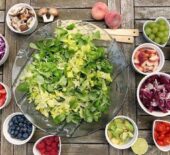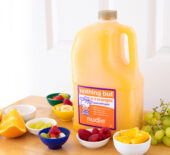If you have read the title of this blog I am not implying you go out and try to eat a rainbow. The smorgasbord of vegetable varieties include all the colours of the rainbow and each vegetable type and colour contains different health benefits for your body. This allows it to function as a well-oiled machine and prevent or reduce your risk of diseases and certain cancers.
How are vegetables similar? All vegetables contain anti-oxidants and anti-cancer properties and protection. These factors help your body to be healthy and to thrive. All vegetable groups also contain fibre which helps your bowels stay happy and healthy, reduce your waistline as well as reducing the ‘bad’ cholesterol. The protection your body receives is optimised when you include a rainbow of variety in your diet. Below are the different colour groups and what they can do for your body to optimise it's health:
- Red Foods:
This group includes the vegetables tomatoes, kidney beans, red chilli, capsicum and red cabbage. The tomatoes in this group contain lycopene can help your prostate stay healthy. The red group may also prevent heart disease, help your vision, immunity and keep your skin glowing.
- Orange Foods:
The orange group includes carrots, pumpkin, sweet potato, orange capsicum and orange lentils. This group may help your heart stay healthy and enhance your eye sight and immunity.
- Green Foods:
Vegetables like broccoli, kale, bussel sprouts, green zucchini, cabbage, bok choy, broad beans, asparagus, green beans and spinach. This food group may decrease your risk of getting type 2 diabetes! The green group contain iron (non-animal source) and folate which helps your body make red blood cells. The ‘greens’ also contains vitamin K and calcium which helps your bones stay strong.
The red, orange and green foods contains beta-carotene which protects our DNA and stops cancer cells from beginning in your body.
- Yellow Foods:
A great colour to increase the visual appeal of a meal and includes yellow capsicum, sweetcorn, yellow tomatoes and zucchini. The ‘yellows’ can help your immunity and help you see well.
- White Foods:
The white group includes onion, shallots, lima beans, cauliflower, leeks and garlic. The white group adds a good source of protein for your body’s cells to grow and energy to live well.
- Brown Foods:
Don’t let the colour turn you off, this colour covers the vegetables like mushrooms, brown lentils, potato and swede. The ‘browns’ provide your body with protein to help your body’s cells grow and energy for life.
- Blue Foods:
Eggplant, beetroot, black olives, purple onion and purple carrot are included in the blue group. By adding this group to your diet it may help prevent heart disease and improve your memory and promote healthy aging!
Take home message: Eat a rainbow of colours! It not only makes your plate or meal look a lot more appealing but will benefit your body in many more ways than selection just type of vegetable. Try adding an extra colour group to your sandwich at lunch or have a look around the fresh food or frozen sections of the supermarket for something different to try. Your taste buds may thank you for the change as well!
References:
- Vegetables, fruits and phytoestrogens in the prevention of diseases. J Postgrad Med. 2004 Apr-Jun;50(2):145-9.
- Carter Patrice, Gray Laura J, Troughton Jacqui, Khunti Kamlesh, Davies Melanie J. Fruit and vegetable intake and incidence of type 2 diabetes mellitus: systematic review and meta-analysis BMJ 2010; 341 :c4229
- Slavin, J. L., & Lloyd, B. (2012). Health Benefits of Fruits and Vegetables. Advances in Nutrition, 3(4), 506–516. http://doi.org/10.3945/an.112.002154








